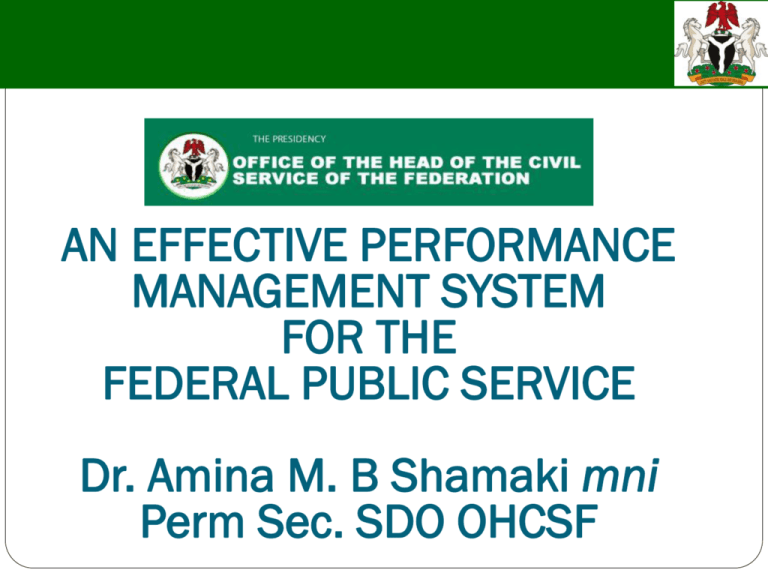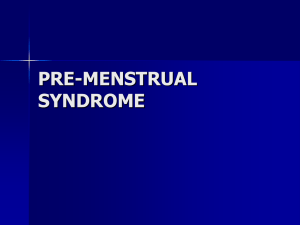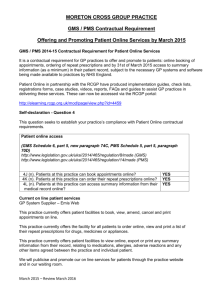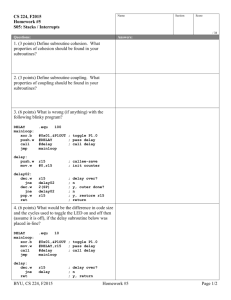Final AN EFFECTIVE PERFORMANCE MANAGEMENT SYSTEM
advertisement

AN EFFECTIVE PERFORMANCE MANAGEMENT SYSTEM FOR THE FEDERAL PUBLIC SERVICE Dr. Amina M. B Shamaki mni Perm Sec. SDO OHCSF Presentation Outline Background Current Efforts To Establish a Performance Management System in Nigeria A Harmonized Performance Management System for the Federal Public Service What is Performance Management System and Its Components Institutional Arrangement Performance management Framework Linkages to Other HR Functions Tools and Templates: Performance Scorecards and Balanced Scorecard Lesson Learnt from Desk Review of PMS Practices Across the Globe Implementing PMS in Nigeria Anticipated Challenges and Proposed Solutions Conclusion BACKGROUND The centrality of Public Service to the achievement of Transformation Agenda, Vision 20:2020 and overall national development cannot be overemphasized. Historically, several reforms have been undertaken which are geared towards: Improving the efficiency and effectiveness of the Public Service, significant among these are the Udoji Reforms of 1974 and the 1988 Civil Service Reforms. Despite these reforms there is still gap in performance and public service delivery. Most pertinent is the dearth of comprehensive performance management system, which has led to unsatisfactory level of performance at sectoral, institutional and individual levels. It is for these reasons that the development and institutionalization of an effective national performance management system is considered as an imperative for the repositioning of the Civil Service. BACKGROUND contd. The only existing element of performance management up until 2012 is the staff appraisal report called the Annual Performance Evaluation Report (APER), which itself has been rendered unreliable as an appraisal instrument. One of the current reform initiatives is the development of a National Strategy for Public Service Reforms (NSPSR), Pillar four of which is the Civil Service Administration Reform (CSAR). The two critical building blocks relevant to performance management are; A comprehensive job evaluation of the Public Service The institutionalization of a Performance Management System for the Public Service CURRENT EFFORTS TO ESTABLISH A PERFORMANCE MANAGEMENT SYSTEM In recognition of the importance of PMS, the President had mandated the three (3) principal agencies key to performance management in the Public Service to develop a comprehensive PMS for the Public Service. In 2010 OHCSF commissioned KPMG Professional Services to develop the performance management system for the Federal Public Service with a focus on the balance score card. In 2011 the Federal Executive Council approved a proposal by the FCSC to replace examinations with Performance Contracting as an instrument for assessment and promotion. Consequently, the FCSC canvased the use of AUTOPASS and COMPASS as performance management tool. In 2012, the President signed Performance Contracts with Ministers under the auspices NPC who supported the development of sectoral KPIs. A HARMONIZED PERFORMANCE MANAGEMENT SYSTEM FOR THE FEDERAL PUBLIC SERVICE From the foregoing, the three stakeholders recognized the need for a harmonized PMS for the Federal Public Service. Consequently, OHCSF, NPC and FCSC have partnered to put in place a Harmonized Performance Management System (PMS) for the Federal Public Service. What is Performance Management System and Its Components Performance Management as a concept is a process by which organizations align their resources, systems and employees to their strategic objectives and priorities PMS is a holistic approach to Performance Management PMS Components are: Institutional Arrangement, Performance Management Framework, Tools and Templates and its linkages with Human Resources Functions. Institutional Arrangement Institutional Arrangement defines the roles and responsibilities of stakeholders in Managing Performance. • Responsibility for the administration of the PMS • Responsibility for key performance indicators • Definition of roles and responsibilities • Responsibility for PMS Policies • Responsibility for Data Management Performance Management Framework Encompasses The Following: Performance Planning Performance Contracting Performance Measurement Performance Monitoring Reporting and Feedback Overarching PMS Policy PMS Technology and Data Management System Performance Management Framework Contd. • Performance Planning: Performance planning is used to provide a structured approach to driving the attainment of the desired level of performance for individuals, teams and institutions. Performance Contracting: This is a component of PMS, which is a management instrument that defines responsibilities and expectations in order to achieve mutually agreed result/ outcomes. The primary means of accomplishing this are through incentives, long-term contracts with specific and measurable levels of operational performance defined by the customer and agreed on by contracting parties This can be used for the evaluation of Chief Executives Officers of MDAs Performance Management Framework Contd. • Performance Measurement: Agreed KPIs & targets which are documented in a Performance Contract/Agreements. • Performance Monitoring, Reporting and Feedback: Performance is measured, monitored and reported at both the institutional and individual levels on an ongoing basis throughout the year. • PMS Policy, Technology and Data Management System Linkages to Other HR Functions • Recruitment and Placement • Learning and Development • Promotion and Progression • Employee Mobility • Succession Planning and Mentoring • Recognition and Reward • Sanctions and Discipline Tools and Templates: Performance Scorecards • Performance scorecards are key elements of the PMS which define the objectives, indicators and targets for both organisations and individuals • The most prominent methodology adopted in developing performance scorecards is the Balanced Scorecard. It is a multidimensional framework for managing and strategically linking objectives, initiatives, targets and performance measures across corporate organisations. Balanced Scorecard This model measures organisational performance from the four key perspectives presented below: Mission & Vision Stakeholders Customers Internal Processes Internal Business Processes Financial Learning and Growth Financial Stewardship Learning and Development Lesson Learnt from Desk Review of PMS Practices Across the Globe • From desk review of practices across the globe, the PMS is in practice in countries such as; United Kingdom and Malaysia which has led to result oriented and improved service delivery to their citizens. • Kenya started initially with the institution of performance contracting as a form of measure for performance evaluation at institutional level but have since commenced PMS for a wider coverage at individual level. Implementing PMS in Nigeria As earlier identified Performance Contracting had commenced at institutional level in Nigeria. For a more virile and wider coverage of performance evaluation, a structured PMS is required at the individual level, for permanent and pensionable appointment in the public service, which is guided by the public service rules. PMS brings to the fore the linkages with other human resources function like; Recruitment and Placement, Promotion and Progression, Employee Mobility, Learning and Development, Talent Management, Mentoring and Succession Planning etc. PMS can also be effectively linked to the Integrated Personnel and Payroll Information System (IPPIS) for more transparent and accountable service delivery Anticipated Challenges and Proposed Solutions Challenges Proposed Solutions Resistance to Change and Dearth of Commitment Dearth of Capacity Dearth of Infrastructure Weak Planning Culture Non-alignment of MDAs to Implement PMS Deficient Job Description Change Management, Attitudinal Change and Ethical Re-orientation in Service Delivery General and Leadership Capacity Building Institutional Strengthening of MDAs Institutionalisation of Strategic Planning Establishment of PMS Unit in all MDAs Development of competency catalogue Anticipated Challenges and Proposed Solutions contd. Unethical Practices Related to Human Resource Functions (Integrity Challenge) Employee Mobility and Promotion Challenges in Pilot Ministries Recognition and Reward for Best Practices, Attitudinal Change and Enforcement of Extant Rules in Sanctions and Discipline Absence of PMS Budget Service wide vote, supplementary budget and Development Partners • Non implementation of PMS evaluation result for Promotion in Pilot Ministries. • No Transfers from and into Pilot Ministries in the Pilot Year • Full rollout of PMS, immediately after the Pilot Year Conclusion The institutionalisation of PMS in the Federal Public Service is a joint effort and entails partnership with all stakeholders. There is no doubt that the implementation of PMS will not only ensure efficient and effective service delivery but will also transform the service to the desired 21st Century optimal Public Service in Nigeria. THANK YOU FOR LISTENING






